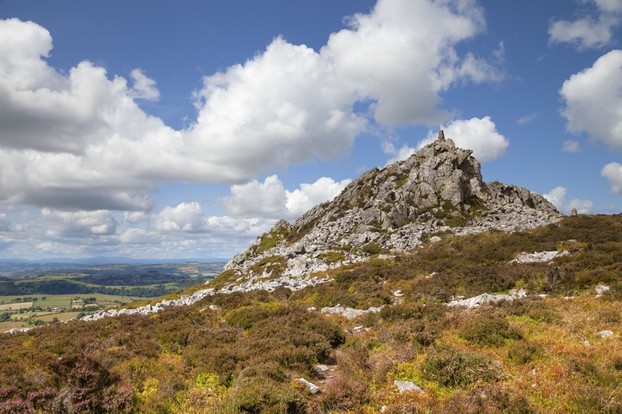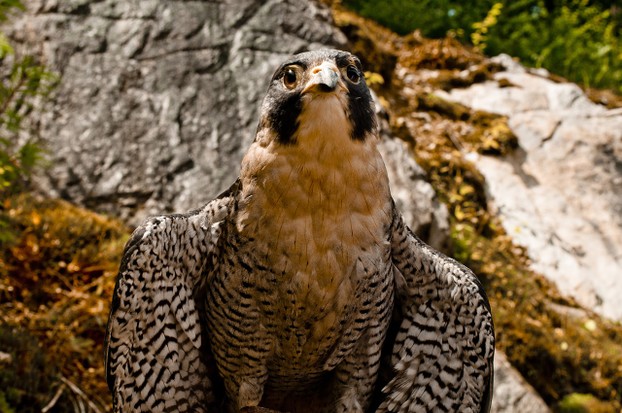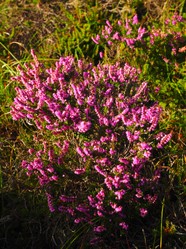I did not meet or see the Devil when I visited Stiperstones Hill, and had I done so, I would have easily broken the world sprint record, but on misty days when the weather comes in from the West over nearby Wales legend has it that he sits on a quartzite tor known as the Devil's Chair, awaiting England's ruin. There is the legend of Slashrags the Tailor, who met the Devil there and only avoided being tricked into Hell when he saw the cloven hoof and tail.Why does the Devil sit there in mist? Cooling down I suppose.
We can easily see why the hill became in mediaeval times a place of legend. It is crowned by six quartzite tors: Shepherd's Rock, Manstone Rock [the largest] Devil's Chair,Nipstone Rock, the Rock, and Cranberry Rock, where the circular walk begins. These jagged and heavily shattered palaeozoic blocks stood out above the ice sheets in the Ice Ages and therefore suffered thousands of years of freeze and thaw, resulting in their being littered with scree. The tors give the place an eldritch appearance, making it quite weird in dim and misty conditions, and it is this mysterious appearance that has made it a place around which legends have gathered.
A spectral figure said to haunt the hill is Wild Edric, a genuinely historical character, a Saxon thane who resisted Norman rule. He has been turned into a legendary nobleman abandoned by a fairy wife and now doomed to return once a year on the Winter Solstice to lead a wild hunt of Shropshire's witches and wizzards, as punishment for his eventual surrender to the Normans, for which his soul is confined to the Stiperstones lead mines with the souls of his wife and men. Solstice is December 21st, and I visited on the 23rd. Just missed him. Oh well! The wild hunt is a mythical event in which pagan deities and their hounds were believed to run wild across the landscape, and it is spoken of in several European cultures. But Edric, the Saxon hero, has another role, for when England is in danger he and his men are said to roam the hill ready to stand against England's enemies. Legend says that they and the Wild Hunt were seen before the Crimean and the two World Wars. In 1853 before the Crimean War a girl from nearby Rorrington claimed to have seen Edric, his wife and the Wild Hunt, but as usually happens with legends, her name is not recorded!
There is also Godgyfu, Lady Godiva, also a historical figure and quite a good woman, whose naked ride through Coventry was meant to force her husband, the earl of Coventry, to lower taxes on the common people. But the legend has it that she is doomed to stalk the hill as she hunted on Sundays. It seems that these historical figures have been linked to legends about the hill by popular legendizing. You can see why she got the blame. A heroine to the Saxon common folk, the Norman rulers and oppressors had to diminish her reputation. A good woman, but on the wrong side of history. Edric' wife, whom some legends call a fairy, was called Godda, so it is easy to see how Godiva and Godda have been confused.
But the Shropshire author Mary Webb spoke of the legends associated with the hill, and said that locals believed that storms gathered round it, and that would be a time when the supernatural host were at large. Having met the hill in a snow storm I can see why they thought like this.











 Women of the Gospelson 10/11/2025
Women of the Gospelson 10/11/2025
 Religious Gardenson 08/25/2025
Religious Gardenson 08/25/2025
 Doctor of the Church: John Henry Newmanon 08/03/2025
Doctor of the Church: John Henry Newmanon 08/03/2025
 Restoring the Palm Houseon 07/16/2025
Restoring the Palm Houseon 07/16/2025



Comments
Some hardy animals, for example English Longhorn cattle, can survive outdoors in cold conditions, but even they suffer in the worst conditions, so farmers take even these animals into barns when conditions are very bad.
Thank you for your comment below in answer to my previous observation and question.
Sheep, so intelligent and so intuitive as to attract the attention of God and of Jesus Christ and of King David, appeal to me what with their generous, kill-free dairy and wool products.
Some Unitedstatesians give cattle, goats, horses and sheep no quarters such as barns. And yet every sentient has to have, in Dylan terms, "shelter from the storm."
Would cows, goats, horses and sheep be left outside 24-7 or would they have available barn-ing in the British Isles?
Yes. Those animals occupy much land.
Thank you for your comment below in answer to my previous observation and question.
Sheep, so beautiful and so prescient in their appearance, behavior, photogenic-ity and products; in their company that they keep, such as King David and Jesus Christ; and in their religious, spiritual associations, abiding on depopulated -- and non-depopulated ;-D -- lands appeals to me.
Is it likelier that available land is inhabited by cattle, goats or sheep in the British Isles?
I think that depopulated land was given over to sheep.
Thank you for your comment below in answer to my previous observation and question.
That almost 1,000 years later some areas such as the Pennine dales are not repopulated adequately intrigues me.
Might it be the ravages or their memory or their combination or something else that realize such a situation?
1: Eldritch is an uncommon word over here. I have never known it used as a surname.
2: There is no preferred version of the death of Edric. But the Wilde family still exist in Shropshire.
3: William was often brutally punitive, for example the wasting of the North in the 1060s. Some areas defined as waste after his ravaging have never been fully repopulated, e.g. some of the Pennine dales.
frankbeswick, Thank you for the photos, practicalities and products.
Generally I associate eldritch with the surname instead of the adjective. Is it common to hear it on your side of the pond?
The internet gives a couple of possibilities for how Eadric the Wild's life ended. Is that the case on your side of the pond or is one version favored over another?
If Eadric survived to fight for Norman England, it makes me wonder if King William could have been a foreshadowing of how we think of Henry VII on this side of the pond: not punitive -- as long as the person was not the contemporary equivalent of King William's Brihtric Meaw -- if the opponent paid huge fines. Would that be the case?
Yes, the whole of the British Isles has a landscape where features are linked to ancient legends and have affinities with "supernatural" figures.
England apparently has much myth and legend.